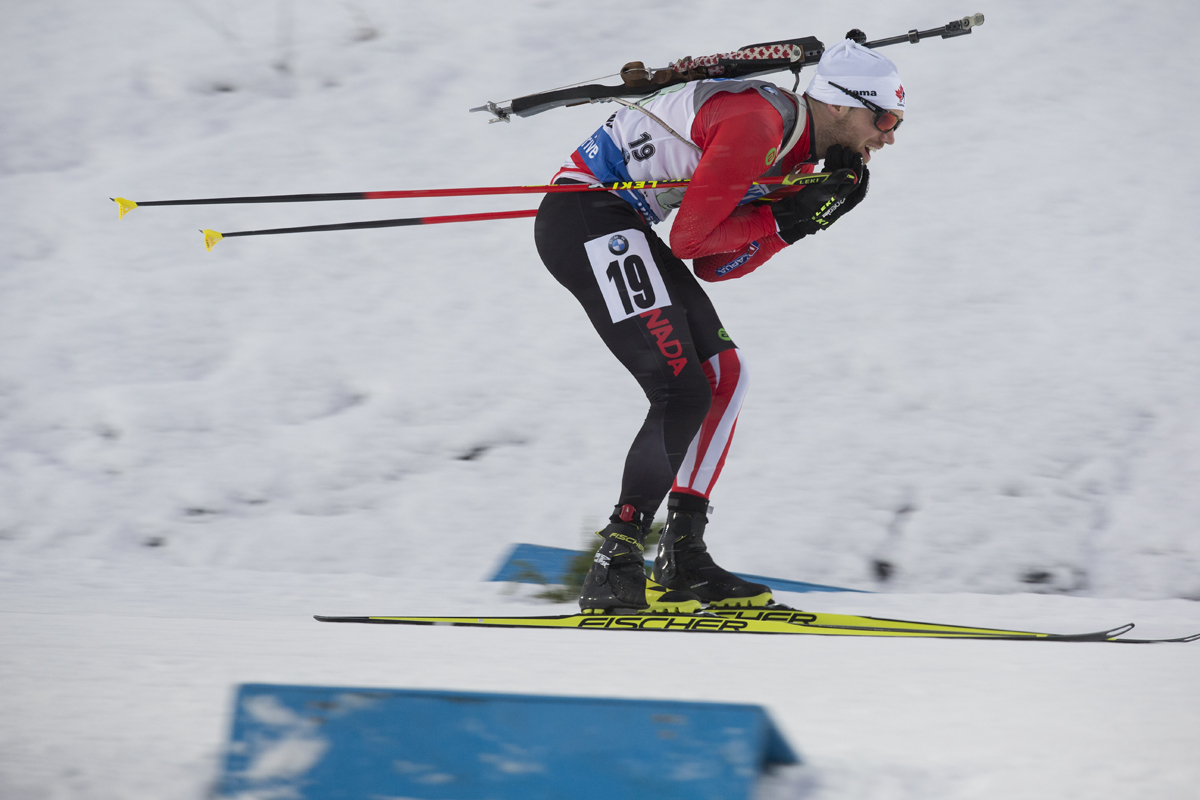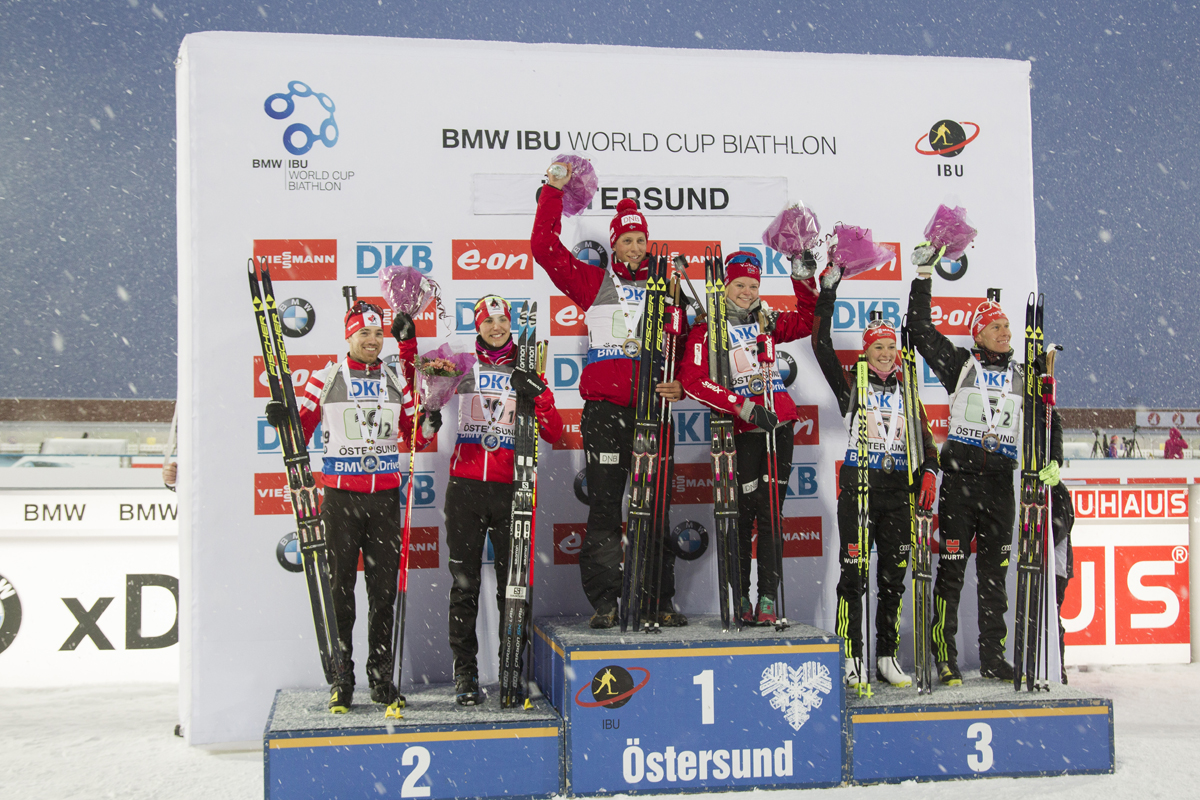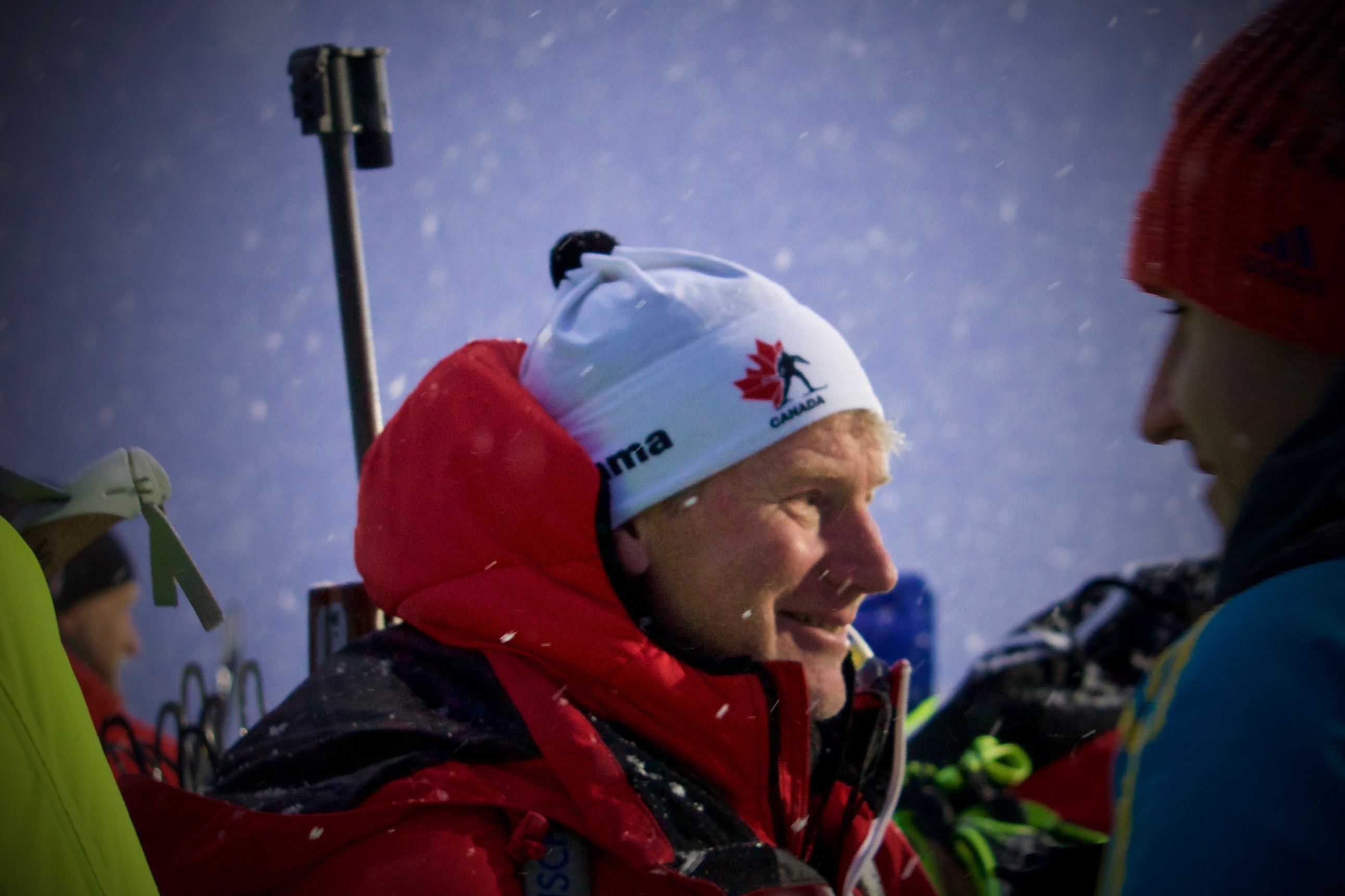
When Nathan Smith crossed the line in today’s World Cup single mixed relay, he thought he had secured third place, Canada’s first-ever relay podium.
Turns out, it was something even better: second, since the French team was slapped with a four-minute time penalty for skipping a penalty loop. That left only the Norwegian team of Kaia Woeien Nicolaisen and Lars Helge Birkeland ahead of him in the results.
It was a nice surprise, Smith laughed.
Along with Rosanna Crawford, he made history for Canada in just the second time this competition has ever been featured on the World Cup.
“It’s a big accomplishment,” Smith said.
The format sees each team member ski short loops with a prone and a standing shooting, then switch off. The whole thing is repeated twice for a total of four shooting stages per skier.

“I did a test event in Oslo two and a half years ago,” Smith said. “I think it was the same format as today- I couldn’t actually remember what even happened in that race, it was so long ago!”
Crawford wasn’t so experienced either.
“I’d never done it before,” she said. “It was kind of funny. Up until Friday, I thought that we only shot twice. But Nathan and I and the coaches and the whole team, we had pretty high expectations and we knew that with some strong shooting, we could for sure be up there. I was trying not to focus so much on that, and just do the task at hand.”
Things didn’t start well for the Canadians, with Crawford picking up four spare rounds in her first race leg.
“Maybe I did let the nerves get to me too much,” she admitted. “I made a correction in prone which wasn’t the right correction, so it was nice to get that information in between our two little races.”
Smith used three spare rounds before tagging back to Crawford in eighth place. With a fresh attitude and two clean stages, she suddenly found herself in podium position.
With such short skiing loops – just a kilometer and a half between each shooting – clean shots could make a difference, and fast.
“I was surprised to tag Nathan in third,” Crawford said. “I thought we were still back in eighth or ninth or something.”

Calm and collected, Smith cleaned his prone stage. That put him in the lead, although he didn’t know it; France was on course in front of him, even though the time penalty put them virtually behind him.
Coming into the range the last time, Smith was side by side with Norway’s Lars Helge Birkeland. While Birkeland used just 19 seconds to clean his targets, Smith needed two spare rounds.
“I knew when France came in with that huge lead that Nathan and I still had an opportunity for first,” Crawford said. “So I was really nervous watching his standing shooting. I had to jog back and forth. But even though he missed two, he did a good job with his spares.”
Smith left the range with Germany’s Daniel Boehm and Sweden’s Tobias Arwidson. The win was gone, but he knew he could still fight for the podium.
“I knew that I was stronger than him at that point, so I chilled behind him until the finishing stretch,” Smith said. “Then I sprinted past him. I knew that was a pretty safe bet to make, instead of going really hard – who knows, that probably would have been fine too, but I wanted to do a sprint at the finish.”
While Smith won silver at last season’s World Championships and then won his first World Cup just two weeks later, it was the first trip to the World Cup podium for Crawford, who has finished fourth and fifth in individual racs.

“It feels amazing,” she said. “I don’t want to downplay it. Those team events, it feels so exciting and I feel so lucky to share the podium with my teammate who I’ve trained with for so long. But also, it’s probably not the same as an individual podium, which is definitely what I’m gunning for this year.”
Both athletes were positive about what the race showed they were capable of in the coming weeks.
“I’m really happy about it,” said Smith. “Last year I did the four-person mixed relay here and it was physically a disaster for me. After flying over my legs just weren’t working. But today I felt pretty strong. After just two or three days I think that’s a really good sign for the rest of the week here.”
But Crawford also tempered her excitement with realism. With a standard four-person mixed relay also on the schedule the same afternoon, teams had to split their athletes into the two events and not every country put their two best into the single mixed relay.
Plus, the very short loop made the race experience quite different than any a biathlete will face in normal individual competition.
“It’s hard to say,” she said of what it all meant. “Not a lot of teams put in their ‘A’ teams. That meant there was even more potential for us, because we knew a lot of people weren’t going to have their best teams.”
Both Crawford and Smith said there was the potential for the pair to team up when this event is held again, although nothing has been decided yet.
“It’s not surprising that we did this well today,” said Smith. “We knew that Rosanna and I are feeling strong, and as long as everything goes well we should be a medal threat… There’s a few things that I will learn from this. I wouldn’t be surprised if you see Rosanna and I doing the single mixed relay again the next time it’s on the calendar.”
The next time the single mixed relay is on the schedule is in Canmore, Alberta, in February. Whether it’s the same lineup or not, Crawford said that the result left the Canadian team excited about what they could accomplish on home soil.
That excitement only grew when the team of Julia Ransom, Zina Kocher, Scott Gow, and Brendan Green finished ninth in the mixed relay – the best result in four years, and with Crawford and Smith watching from the sidelines.
“I’m super proud of them,” Crawford said. “It was Julia’s first time leading off a relay, which is always extra stressful, but she did a super good job in prone, and Zina pulled it together on the range. Brendan had a little bit of a struggle with his standing but to be in the top ten is a really good result for us.”
After a successful day, she’s enthusiastic about the future of Canadian biathlon.
“I don’t want to say this like I’m patting myself on the back or anything, but we’ve helped build this team by slowly but surely getting good results, the older athletes, which means that these younger athletes get to have really good training opportunities that maybe we didn’t have at their age,” Crawford mused. “I think that’s fostering a really good environment on the team, that we want everyone to do well: we want the older athletes to do well because that means more funding, and we want the younger athletes to do well because they are the ones who will eventually replace us.”
Chelsea Little
Chelsea Little is FasterSkier's Editor-At-Large. A former racer at Ford Sayre, Dartmouth College and the Craftsbury Green Racing Project, she is a PhD candidate in aquatic ecology in the @Altermatt_lab at Eawag, the Swiss Federal Institute of Aquatic Science and Technology in Zurich, Switzerland. You can follow her on twitter @ChelskiLittle.



